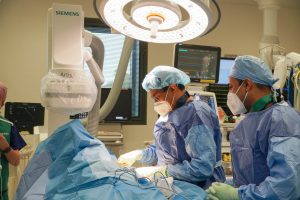Cardiologists at the Royal Adelaide Hospital have successfully conducted South Australia’s first procedure using the latest generation of cardiac techniques used to correct common heart rhythm disorders.
The surgical team was in live contact with engineers and specialists from Boston Scientific based in San Francisco, USA.
Known as pulse-field ablation, the state-of-the-art procedure is more precise, faster and safer.
A game-changer
Heart rhythm disorders are the most common cardiac issue patients come to emergency departments for.
Ablation procedures restore a normal heart rhythm by modifying the cardiac tissue that causes irregular electrical signals.
Lead surgeon Professor Prashanthan Sanders, Director of the Centre for Heart Rhythm Disorders at the Royal Adelaide Hospital says the new technique has multiple benefits.
“This technology will mean we will be able to offer ablation for atrial fibrillation to more South Australians and potentially at an earlier stage to prevent complications associated with atrial fibrillation,” he said.
Cutting-edge tech
The new technique replaces the previous methods, which use a catheter to apply extreme heat or cold to many points of the heart to scar the tissue, like a branding iron.
Instead, the new technique, carried out for the first time by Dr Mehrdad Emami, applies ultra-rapid electrical pulses across a larger surface area all at once. By not changing temperature, the more precise technique means there’s no risk of damaging nearby tissues such as nerves, the oesophagus or lungs.
“Pulsed field ablation is quick and more specific to heart tissue. A shorter procedure which focuses better on the tissue that needs treatment means that the procedure risks are significantly reduced. A shorter procedure means the recovery is quicker and will facilitate what was a complex procedure being undertaken as a day case,” said Professor Sanders.

Photo: South Australia’s first pulse field ablation procedure performed by Professor Prashanthan Sanders (left) and Dr Merdad Emami.
Better, faster, safer
As well as being more precise and safer, other benefits of the new technique include:
- reduced cost
- less need for anaesthesia
- shorter length of stay in hospital
- faster procedure time
Patients will go from having to undergo a two- to four-hour procedure with an overnight stay, to a procedure of less than one hour with potential for patients to return home the same day.
These improvements are a result of Professor Sanders and his colleagues at Centre for Heart Rhythm Disorders at the Royal Adelaide Hospital to further improve the success and safety of undertaking the procedure.

Photo: The surgical team was in live contact with engineers and specialists from Boston Scientific based in San Francisco, USA.



